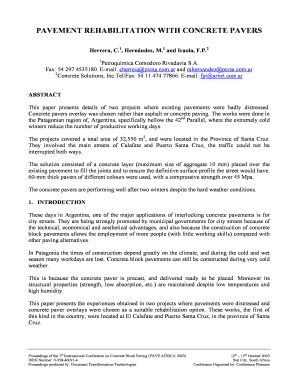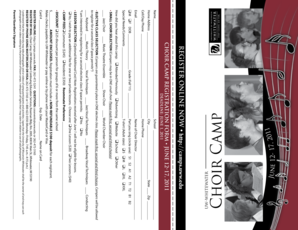Sample Abstract For Paper Presentation
What is sample abstract for paper presentation?
A sample abstract for paper presentation is a concise summary of a research paper or presentation that provides an overview of the study's objectives, methodology, and results. It is usually written in the form of a short paragraph and is often used to give potential readers or attendees a glimpse into the content of the paper or presentation.
What are the types of sample abstract for paper presentation?
There are different types of sample abstracts for paper presentations, depending on the specific requirements or guidelines provided. Some common types include:
Descriptive abstracts: These provide a summary of the paper's content and key points without explicitly stating the results or findings.
Informative abstracts: These provide a summary of the paper's content, methodology, results, and conclusions.
Structured abstracts: These follow a specific format, with headings or subheadings such as Introduction, Methods, Results, and Conclusion.
Poster abstracts: These are specifically designed for poster presentations and focus on conveying key information concisely.
How to complete sample abstract for paper presentation
To complete a sample abstract for a paper presentation, follow these steps:
01
Read the guidelines: Familiarize yourself with any specific requirements or guidelines provided for the abstract.
02
Understand the purpose: Clearly identify the objective of your research or presentation and think about what key information you want to convey.
03
Summarize your work: Write a concise summary of your research paper or presentation, highlighting the key points, methods used, and results obtained.
04
Use clear language: Choose your words carefully to ensure your abstract is easy to read and understand.
05
Proofread and revise: Take the time to review and revise your abstract for clarity, grammar, and overall cohesiveness.
06
pdfFiller and its features: A mention that pdfFiller empowers users to create, edit, and share documents online. Offering unlimited fillable templates and powerful editing tools, pdfFiller is the only PDF editor users need to get their documents done.
By following these steps, you can create a strong and effective abstract for your paper presentation.
Thousands of positive reviews can’t be wrong
Read more or give pdfFiller a try to experience the benefits for yourself
Questions & answers
How do you write an abstract example?
The abstract should begin with a brief but precise statement of the problem or issue, followed by a description of the research method and design, the major findings, and the conclusions reached.
What are the 5 basic contents of your abstract?
The five main elements to include in your abstract are stated below. Introduction. This is the first part of the abstract, and should be brief and attractive to the reader at the same time. Research significance. This usually answers the question: Why did you do this research? Methodology. Results. Conclusion.
What are the 5 parts of an abstract?
However, all abstracts generally cover the following five sections: Reason for writing: What is the importance of the research? Problem: What problem does this work attempt to solve? Methodology: An abstract of a scientific work may include specific models or approaches used in the larger study. Results: Implications:
What are 5 abstract words?
Love, fear, anger, joy, excitement, and other emotions are abstract nouns. Courage, bravery, cowardice, and other such states are abstract nouns. Desire, creativity, uncertainty, and other innate feelings are abstract nouns.
How do you write an abstract for a paper presentation?
Quick Tips Comply. Diligently follow all abstract style and formatting guidelines. Be Concise. With a 250-500 word limit, write only what is necessary, avoiding wordiness. Be Clear. Plan your abstract carefully before writing it. Be Clean. Revise and edit your abstract to ensure that its final presentation is error free.
What are the 4 components of an abstract?
The usual sections defined in a structured abstract are the Background, Methods, Results, and Conclusions. other headings with similar meanings may be used (eg, Introduction in place of Background or Findings in place of Results).
Related templates





















